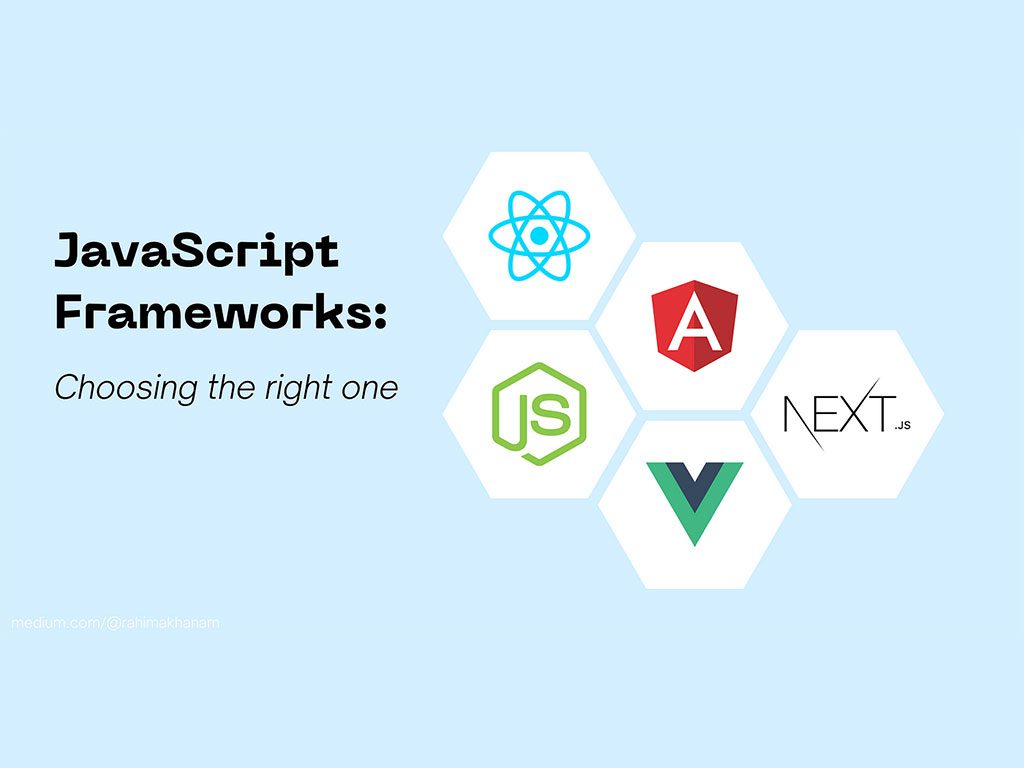JavaScript has become an essential language for web development, enabling developers to create dynamic and interactive websites. With the increasing complexity of web applications, JavaScript frameworks and libraries have emerged to simplify the development process and provide a structured approach to building scalable and maintainable code.
JavaScript frameworks, such as React, Angular, and Vue, offer a comprehensive set of tools and libraries that streamline the development process by providing pre-built components, data management solutions, and routing capabilities. On the other hand, JavaScript libraries, like jQuery and lodash, focus on providing specific functionality that can be easily integrated into existing projects.
Understanding the difference between JavaScript frameworks and libraries
While the terms “framework” and “library” are often used interchangeably, there is a subtle difference between the two. A JavaScript framework provides a complete structure for building web applications, offering a set of predefined rules and conventions. It dictates the architecture of the application and provides guidelines on how different components should interact with each other. On the other hand, a JavaScript library offers a collection of functions and utilities that can be used to enhance the functionality of an application. It doesn’t impose any specific structure or architecture on the application and can be easily integrated into existing projects.
The importance of choosing the right JavaScript framework for your project
Choosing the right JavaScript framework is crucial for the success of your project. With a plethora of options available, it can be overwhelming to make the right choice. The right framework can significantly improve development efficiency, code quality, and maintainability, while the wrong one can lead to unnecessary complexity, slow performance, and difficulty in scaling the application.
Overview of the state of JavaScript and popular frameworks in the industry
JavaScript has evolved rapidly over the years and has become the de facto language for web development. The language itself has seen significant improvements, with the introduction of features like arrow functions, classes, and modules. The JavaScript ecosystem is vast, with numerous frameworks and libraries available for different purposes.
Some of the most popular front-end JavaScript frameworks include React, Angular, and Vue. React, developed by Facebook, is known for its component-based architecture and virtual DOM rendering. Angular, developed by Google, offers a complete solution for building large-scale applications with features like dependency injection and two-way data binding. Vue, on the other hand, is a lightweight framework with a gentle learning curve, making it ideal for small to medium-sized projects.
In the back-end JavaScript space, Node.js has gained significant popularity. Node.js allows developers to run JavaScript on the server side, enabling them to build scalable and high-performance web applications. Express.js, a minimalist web framework built on top of Node.js, is widely used for building server-side applications.
Comparison of front-end JavaScript frameworks
When choosing a front-end JavaScript framework, several factors need to be considered. Some of the key aspects to evaluate include performance, community support, learning curve, ecosystem, and scalability.
React, with its virtual DOM and component-based architecture, provides excellent performance and is highly scalable. It has a large and active community, with a vast ecosystem of libraries and tools. However, the learning curve can be steep, especially for beginners.
Angular, with its two-way data binding and dependency injection, offers a comprehensive solution for building complex applications. It has a mature ecosystem and excellent community support. However, Angular has a steeper learning curve compared to React and Vue.
Vue is known for its simplicity and ease of use. It has a gentle learning curve, making it ideal for beginners. Vue also has excellent performance and a growing community. However, the ecosystem is relatively smaller compared to React and Angular.
Comparison of back-end JavaScript frameworks
In the back-end JavaScript space, Node.js is the dominant player. It provides a scalable and high-performance runtime for running JavaScript on the server side. When it comes to choosing a back-end framework, Express.js is the most popular choice. Express.js is a minimalist and flexible framework that allows developers to build server-side applications with ease. It has a vast ecosystem of middleware and plugins, making it highly extensible. Other notable back-end frameworks include Koa.js and Hapi.js, which provide more advanced features and emphasize code readability and simplicity.
Factors to consider when choosing a JavaScript framework
When choosing a JavaScript framework, several factors need to be taken into account. These include the project requirements, development team expertise, community support, learning curve, performance, scalability, and long-term maintainability.
The project requirements should guide the choice of framework. Different frameworks have different strengths and weaknesses, so it’s important to select one that aligns with the project goals. The expertise of the development team is also crucial. Choosing a framework that the team is familiar with can significantly improve productivity and reduce the learning curve.
Community support is another important factor to consider. A large and active community ensures that the framework is well-maintained, with regular updates and bug fixes. It also means that there are plenty of resources and tutorials available for learning and troubleshooting.
Performance and scalability are critical for modern web applications. Evaluating the performance benchmarks and scalability of a framework can help make an informed decision. Long-term maintainability should also be considered, as choosing a framework with good documentation and a stable release cycle can ensure that the application remains compatible and up-to-date with future changes.
Best practices for evaluating and selecting a JavaScript framework
To evaluate and select a JavaScript framework, it’s essential to follow some best practices. Firstly, it’s important to conduct thorough research and gather information about different frameworks. Reading documentation, tutorials, and case studies can provide valuable insights into the strengths and weaknesses of a framework.
Creating a proof of concept or a small prototype using the framework can help evaluate its suitability for the project. This can involve building a simple application or implementing a specific feature to assess the ease of use, performance, and compatibility with existing code.
Seeking feedback from other developers and the community can also provide valuable insights. Participating in online forums, attending meetups, and engaging with the community can help gather opinions and experiences from those who have already used the framework.
Considering the long-term viability of the framework is crucial. This involves evaluating its roadmap, release cycle, and community support. Choosing a framework that has a clear vision, regular updates, and an active community can ensure the longevity and stability of the project.
Case studies of successful projects using different JavaScript frameworks
Numerous successful projects have been built using different JavaScript frameworks. For example, Facebook developed React to build their own web applications, including Facebook, Instagram, and WhatsApp. React’s component-based architecture and virtual DOM rendering have enabled Facebook to create highly interactive and performant user interfaces.
Google’s Angular has been used to build large-scale applications like Google Analytics and Google Cloud Console. Angular’s powerful features, such as dependency injection and two-way data binding, have made it a popular choice for enterprise-level projects.
Vue has gained popularity among startups and small to medium-sized projects. Alibaba, Xiaomi, and Baidu are some of the companies that have used Vue to build their web applications. Vue’s simplicity and ease of use have made it an attractive option for rapid development.
Resources and tools for learning and mastering JavaScript frameworks
Learning and mastering JavaScript frameworks require continuous learning and practice. Fortunately, there are numerous resources and tools available to assist in this journey.
Online tutorials and documentation provided by the framework creators are excellent starting points. These resources provide step-by-step guides, code examples, and explanations of core concepts.
Community-driven resources, such as blog posts, video tutorials, and podcasts, can provide different perspectives and insights into using the framework effectively. Online forums and Q&A sites, like Stack Overflow, are also great places to seek help and connect with other developers.
Practice projects and coding challenges can help solidify the knowledge gained. Websites like CodePen and GitHub offer a vast collection of open-source projects and coding exercises to practice and explore different aspects of the framework.
Conclusion
Choosing the right JavaScript framework is a critical decision that can significantly impact the success of your project. By understanding the difference between frameworks and libraries, evaluating the state of JavaScript, comparing front-end and back-end frameworks, considering the factors that matter, following best practices, and learning from successful case studies, you can make an informed decision.
Remember to align the framework choice with your project requirements, development team expertise, and long-term goals. Continuously learn and practice using available resources and tools to master the chosen framework. By following these guidelines, you can confidently select the best JavaScript framework for your project and build scalable, maintainable, and high-performing web applications.
Call to Action:
Ready to take your web development skills to the next level? Explore the world of JavaScript frameworks and choose the right one for your project. Start by evaluating your project requirements, considering the factors that matter, and learning from successful case studies. Remember to continuously learn and practice using available resources and tools. With the right framework in hand, you’ll be on your way to building powerful and modern web applications.







